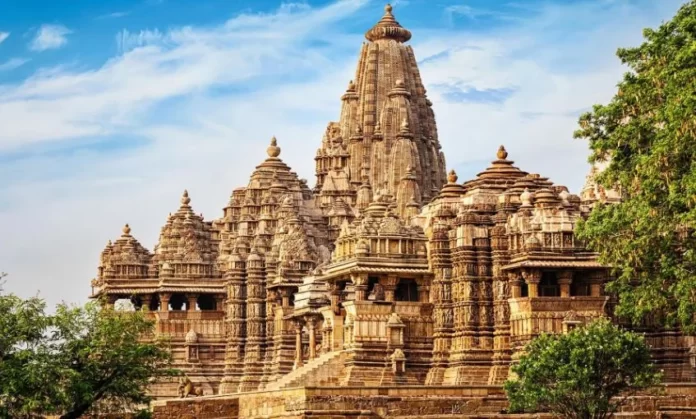Khajuraho Temples are a group of famous Hindu and Jain temples located in the Chattarpur district of Madhya Pradesh. Here are 15 Facts About Khajuraho Temple.
Khajuraho Temples are a group of famous Hindu and Jain temples located in Khajuraho, a small town in Chhatarpur district. These temples are renowned for their intricate and exquisite carvings that depict various aspects of life, sensuality, spirituality, and mythology.
The Khajuraho Temples showcase a unique blend of Nagara and Dravidian architectural styles. The grandeur of the temples is enhanced by towering spires (shikhara), intricately carved pillars, and ornate sculptures.
Facts About Khajuraho Temple
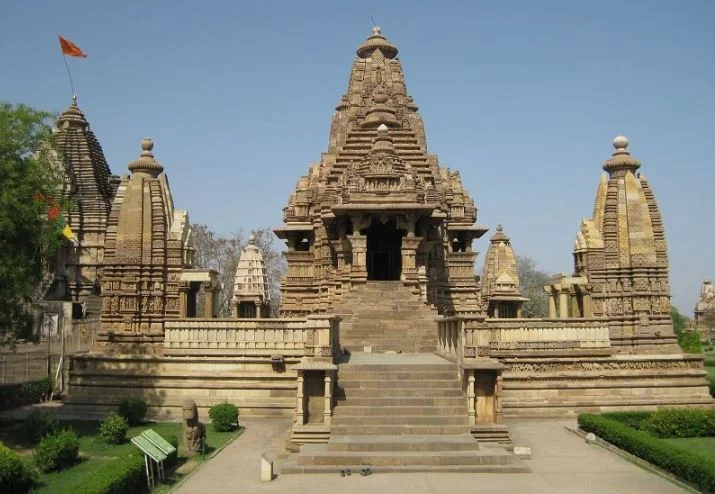
Here are 15 interesting Facts about Khajuraho Temple.
1. Historical Facts about Khajuraho Temple
Khajuraho Temple was Built between the 9th and 12th centuries by the Chandela dynasty. Khajuraho Temples are considered a UNESCO World Heritage Site.
- The temples are divided into three groups: Western, Eastern, and Southern.
- The Western Group, comprising the largest and most well-preserved temples, attracts the majority of visitors.
- The Khajuraho Temples were built during the Chandela dynasty between the 10th and 12th centuries, reflecting the architectural and artistic brilliance of that era.
- These temples are considered masterpieces of medieval Indian architecture and were added to the UNESCO World Heritage List in 1986.
- The temples were dedicated to various deities, including Lord Shiva, Lord Vishnu, and various forms of the Goddess.
- Over time, the temples fell into obscurity and were rediscovered by British surveyor T.S. Burt in the 19th century.
- Today, the Khajuraho Temples are an important pilgrimage site, as well as a popular tourist attraction, attracting visitors from around the world.
2. Architectural Facts about Khajuraho Temple
The temple complex is famous for its erotic sculptures, which form a significant part of the intricate carvings. These sculptures, depicting various poses, reflect the ancient Indian philosophy of embracing physical and spiritual aspects of life.
- The Khajuraho Temples are renowned for their exquisite stone carvings, depicting a wide range of subjects, including gods, goddesses, celestial beings, humans, animals, and erotic art.
- The temples exhibit a fusion of Nagara and Dravidian architectural styles, characterized by soaring shikhara (spires), intricate sculptures, and intricately carved pillars.
- The intricate carvings on the temple walls depict various aspects of life, spirituality, and mythology, showcasing the artistic skills of the craftsmen of that time.
- The temples are adorned with intricate sculptures of deities, apsaras (celestial nymphs), musicians, dancers, and erotic art that symbolizes fertility and union.
- The architectural grandeur of the temples is a testament to the rich cultural and artistic heritage of ancient India.
3. Temple Layout
The Khajuraho Temples are divided into three geographical groups: the Western, Eastern, and Southern groups.
- The Western group is the largest and most well-known, featuring notable temples like the Kandariya Mahadeva Temple, Lakshmana Temple, and Vishvanatha Temple.
- The Eastern group consists of smaller temples dedicated to various deities, with the Parsvanatha Temple being the most famous among them.
- The Southern group houses the Duladeo Temple and the Chaturbhuj Temple, among others.
- Each group of temples has its own distinct architectural style and layout, adding to the diversity and magnificence of the Khajuraho Temples.
4. Erotic Sculptures Facts about Khajuraho Temple
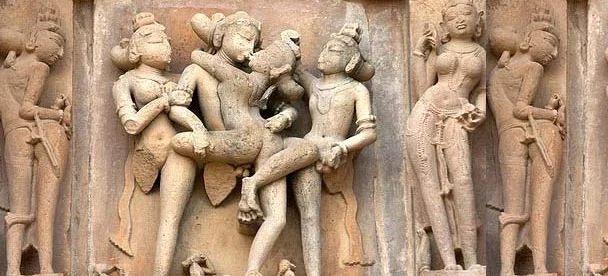
One of the unique features of the Khajuraho Temples is the presence of erotic sculptures depicting various sexual positions and acts.
- These sculptures are found predominantly in the Western group of temples, particularly the Kandariya Mahadeva Temple.
- The erotic art is considered an integral part of temple architecture and symbolizes the celebration of love, fertility, and the union of male and female energies.
- These sculptures are intricately carved and showcase the sensuality and beauty of human form, capturing the attention of visitors and scholars alike.
- The erotic art at Khajuraho has been widely studied and interpreted as a representation of the Tantric traditions and the pursuit of spiritual enlightenment through physical pleasure.
5. Spiritual Facts about Khajuraho Temple
The Khajuraho Temples are not merely architectural marvels but also hold deep spiritual significance for devotees and visitors.
- The temple complex is designed to represent a microcosm of the Hindu universe, with each temple dedicated to a specific deity or aspect of divinity.
- The temple structures, sculptures, and carvings are filled with symbolic meanings, conveying spiritual teachings and stories from ancient Hindu scriptures.
- The intricately carved pillars, mandapas (halls), and sanctums create a sacred atmosphere, inviting visitors to connect with the divine and experience inner transformation.
- The temples continue to be active places of worship, with regular rituals, ceremonies, and festivals being conducted to honor the deities and seek their blessings.
6. Preservation Efforts
The Khajuraho Temples have undergone extensive restoration and preservation efforts to protect their architectural heritage.
- The Archaeological Survey of India (ASI) has been actively involved in conserving and maintaining these temples since the 1960s.
- Conservation measures include structural stabilization, cleaning of sculptures, and documentation of intricate carvings.
- The temples have also been protected from environmental factors such as pollution, weathering, and natural disasters through the installation of canopies and other protective measures.
- These preservation efforts ensure that future generations can appreciate the beauty and historical significance of the Khajuraho Temples.
7. Festivals Facts about Khajuraho Temple
The Khajuraho Temples are known for hosting vibrant festivals and celebrations that attract both locals and tourists.
- The most famous festival celebrated here is the Khajuraho Dance Festival, held annually in February/March.
- During the festival, renowned classical dancers from all over the country perform against the backdrop of the beautifully lit temple complex.
- The festival showcases various forms of Indian classical dance, including Kathak, Bharatanatyam, Odissi, and more, highlighting the rich cultural heritage of India.
- Other festivals celebrated at the temples include Mahashivaratri, Navratri, and Diwali, where devotees gather to offer prayers, participate in rituals, and seek blessings from the deities.
8. Symbolism of Sculptures
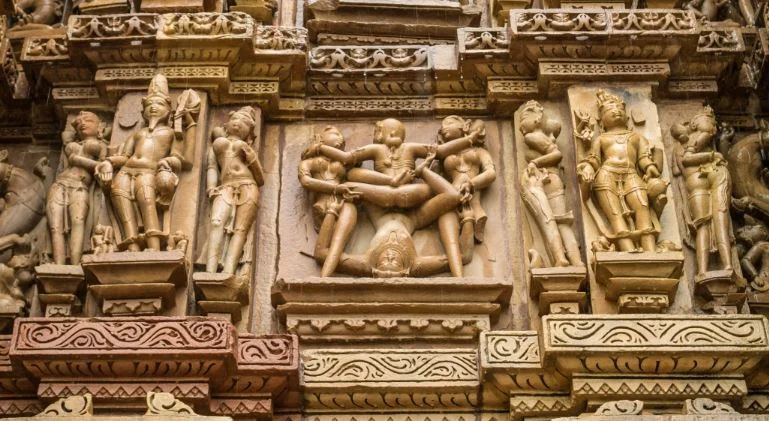
The sculptures at the Khajuraho Temples are not only artistic but also laden with symbolic meanings.
- The sculptures depict deities, celestial beings, humans, animals, and various mythological scenes that convey spiritual and moral lessons.
- The carvings often depict gods and goddesses in various forms and poses, symbolizing their attributes and divine qualities.
- The sculptures also illustrate stories from Hindu mythology, such as the Ramayana and Mahabharata, serving as a visual representation of these ancient epics.
Each sculpture is carefully crafted to convey a specific message or teach a moral lesson, inviting contemplation and reflection.
9. UNESCO World Heritage Site
The Khajuraho Temples were designated as a UNESCO World Heritage Site in 1986.
- The UNESCO recognition acknowledges the outstanding universal value of the temples and their significance in human history and culture.
- The temples are considered a masterpiece of medieval Indian architecture and a testimony to the artistic and cultural achievements of the Chandela dynasty.
- The UNESCO status has contributed to the conservation and promotion of the temples, attracting more visitors and ensuring their preservation for future generations.
- The recognition also highlights the global significance of the Khajuraho Temples as a cultural heritage site.
10. Spiritual Tourism
- The Khajuraho Temples attract a large number of tourists, both domestic and international, who are drawn to their architectural splendor and spiritual ambiance.
- The temples serve as a pilgrimage site for Hindus and Jains, offering a sacred space for prayer, meditation, and seeking blessings.
- The serene surroundings and the divine atmosphere of the temples create a conducive environment for spiritual exploration and introspection.
- Many visitors come to Khajuraho to experience the spiritual energy of the temples, participate in rituals, and witness the religious ceremonies conducted by the priests.
- The tourism industry in Khajuraho has developed around the temples, providing accommodation, guided tours, and cultural activities to cater to the needs of visitors.
11. Symbolism of Temple Layout
The layout of the Khajuraho Temples follows the principles of sacred geometry and aligns with cosmic symbolism.
- The temples are constructed on a high platform called a Jagati, symbolizing the earth and its stability.
- The main entrance of each temple faces the east, signifying the direction of the rising sun and the path of enlightenment.
- The inner sanctums are strategically positioned to align with the cosmic energies, emphasizing the connection between the earthly and divine realms.
- The overall temple complex is designed to create a spiritual journey for devotees, leading them from the outer courtyard to the innermost sanctum, representing the progressive stages of spiritual realization.
12. Varied Sculptural Themes
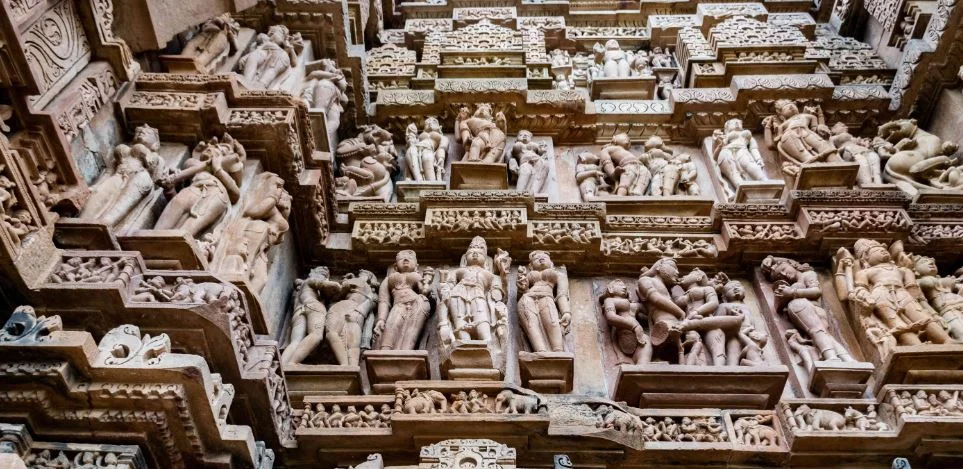
The sculptures at Khajuraho Temples cover a wide range of themes, reflecting the diversity of ancient Indian life and beliefs.
Apart from the iconic erotic sculptures, there are also depictions of everyday life activities like farming, hunting, music, dance, and various occupations.
- Mythological scenes, such as the divine marriage of Lord Shiva and Parvati or the battle between gods and demons, are also prominently featured.
- Sculptures showcasing different aspects of nature, including animals, birds, and plants, highlight the harmony between humans and the environment.
- The varied sculptural themes offer a glimpse into the social, cultural, and religious practices prevalent during the time of their construction.
13. Intricate Architecture Details
The architectural details of the Khajuraho Temples exhibit a high level of craftsmanship and attention to detail.
- The carvings on the temple walls include intricate patterns, geometric designs, and ornamental motifs, showcasing the mastery of ancient Indian artisans.
- The pillars inside the temples are adorned with delicate carvings of deities, mythical creatures, and divine beings.
- The ceilings of the mandapas feature elaborate ceiling panels with mesmerizing patterns and sculptural reliefs.
The interplay of light and shadow enhances the visual appeal of the architectural elements, creating a captivating atmosphere.
14. Astronomical Observatories
Some scholars believe that the Khajuraho Temples served as astronomical observatories due to their alignment with celestial events.
- The sculptures and temple structures are positioned in such a way that they align with the movement of the sun, moon, and stars during specific times of the year.
- The placement of windows and doorways allows sunlight to enter the sanctums at specific angles during equinoxes and solstices.
- It is believed that the priests used these alignments to determine auspicious timings for rituals and festivals.
- The integration of astronomy into temple architecture reflects the deep connection between spirituality, cosmology, and the natural world.
15. Influence of Tantra
The Khajuraho Temples showcase elements of Tantric philosophy and practices, which emphasize the union of masculine and feminine energies for spiritual enlightenment.
- The erotic sculptures are believed to represent the union of Shiva and Shakti, the divine masculine and feminine principles.
- The Tantric philosophy perceives physical desire as a means to attain spiritual transcendence and inner transformation.
- The presence of erotic art in the temples signifies the recognition and acceptance of human desires as a part of the spiritual journey.
- The temples thus serve as a place where devotees can explore the interplay of physical and spiritual realms and seek a deeper understanding of their own nature.
How to Reach Khajuraho Temple?
Khajuraho is well-connected by road, rail, and air. The nearest airport is Khajuraho Airport, located just a few kilometers away from the town. The temples are a popular tourist attraction, drawing visitors from around the world who come to marvel at the stunning craftsmanship and architectural brilliance displayed in these ancient structures. Now let’s see an article that consists of 15 Facts About Khajuraho Temple.
Related Posts
- 21 Facts About Vaishno Devi
- 19 Facts About Amarnath
- 21 Facts About Kedarnath
- 27 Facts About Badrinath
- 16 Facts About Gangotri
- 17 Facts About Yamunotri
